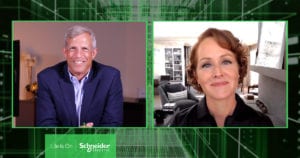I just got back from the Microsoft Worldwide Partner conference in Houston where 15,000 of us heard the latest news about Microsoft’s product lineup and strategy. One of the main announcements at the event was the launch of Microsoft’s CityNext initiative, a broad portfolio of products, technologies and partners intended to help cities scale out services, meet evolving expectations, and find new ways to control costs.
Schneider Electric has been using Microsoft tools to develop software applications such as SCADA for years. But only recently, after our acquisition of Telvent in 2011, have we begun to leverage the power of partnering with Microsoft to accelerate development, time to market and to ramp up sales.
It’s therefore no surprise to see our Smart Infrastructure (formerly Telvent) team leading the way to exploit the power of Microsoft’s Azure Cloud platform with the announcement of its Orbit mobile inspection Software as a Service (SaaS) offering.
Orbit is a system that facilitates the execution of work tasks in the field. It allows utility field crews and coordinators to know what’s happening in real time and do their work more efficiently. On an internal webinar recently, it was interesting to learn what our product manager thought were the advantages of developing this on the Microsoft Azure platform. Cloud providers offer access, as a service, to multiple flexible, server-based computational resources. In one package, Windows Azure provides both infrastructure (IaaS) and key platform (PaaS) technology that allows us to focus on developing the SaaS solution. Not a single provider can do this like Microsoft.
What this really means to us is less time and money spent purchasing, operating, and maintaining infrastructure and platform technology, which directly translates to a faster return on investment. Offloading ownership of the infrastructure and platform reduces the burden required to maintain them, leaving more time to focus on developing valuable end user applications and providing a faster route to market. For our customers, we can now scale up the capacity of the offering on demand, roll out incremental enhancements and provide mobile workers with apps on numerous devices including Windows tablets.
This sets the scene nicely for Schneider Electric to be joining Microsoft’s CityNext initiative. We have applications for electric, gas and water utilities, building energy efficiency, sustainability, public safety and more developed using Microsoft tools. We’ll be looking to see which of these applications can advantage of the Azure Cloud platform, with several more solutions in the next year. Of course, some will migrate sooner than others. Utilities, in particular, have many issues to work through before they will allow their data to be taken off premise, including security and latency. What I learned in Houston is that the public sector in general is a big advocate of cloud-based apps. For non-critical applications, cloud seems like an attractive route.
As Schneider-Electric’s SVP for Smart Cities, Charbel Aoun, stated: “Our participation in Microsoft CityNext demonstrates our belief that collaboration among industry players is essential to help cities become more efficient, livable and sustainable. The combination of Microsoft platform technology with our broad portfolio of solutions, software and services will help cities improve the efficiency of their urban infrastructures, thus ensuring better public services and enabling new, innovative services for the city and its people. Making cities smarter requires a profound transformation of existing models; tackling it collectively, through the involvement of citizens and city officials, local and global businesses, as well as academia, makes it real.”
I’m looking forward to seeing what our partnership comes up with in the next year or two. Watch this space.



Conversation
Excellent article Alistair. Looking forward to more discussion internally and with customers on how we can leverage each other’s strengths moving forward.
Thanks for posting Alistair! will share with team